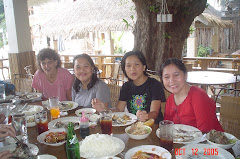It was disheartening that three of our women participants could not make it to the training because they lack the money or transportation allowance (though we keep re-assuring them that they can re-imburse it after the day's training). I believe this is just a reflection of how hard the times is. No one wants to lend them money for fare. Perhaps, we can reconsider giving them an allowance a day before the training (though that may seem so tasking from the organizers), I think empowering women is finding practical ways of addressing their concerns, no matter how big or small it is. I believe in the principle of supporting them 'all the way' (even out of one's pocket). This principle entails patience and sustainability. Patience in finding ways of addressing the multi-faceted concerns of women, easing the obstacles that blocked women's learning and being there to support them perhaps in a more sustained way.
In this training, I have witnessed these values at work. First, we (the facilitators) translated the lessons (computer language may sound too technical) in the simplest language understandable to the women. Second, we patiently instructed the women on the nitty-gritty of operating the software (even if we have to initially operate the computer on a "pindot" or one finger system of typing).
Thirdly, even if we have to shell out money from our own pockets just to be able to provide the women some food.
But the joy of it all comes when the women themselves are confident in navigating the cyberspace by themselves. I think this is just a glimpse of how this ICT training empower grassroots women (both young and maturing).
Sunday, March 22, 2009
Thursday, March 12, 2009
Kinari dance
Sounds like "canary" dance. But it is actually a bird's dance. We attended a session facilitated by three Indian women named Shiva, Shatan (?) and Mina. They are from Kerala, India. they taught us this dance. Actually, it is more complicated than I thought. Initially, they taught the various finger movements, 28 in total but we only used two: partaka and hamsasya. We greeted each other and introduced our surroundings using those two finger movements. Partaka is just spreading the four fingers straight: small up to the index finger and clipping the thumb finger. The Hamsasya is touching of the thumb and the index finger (creating a circle) and the rest of the fingers pointing upwards. Then, we were taught the foot steps. The left foot in initially turning to the left and then the right foot stomped at the ankle of the right, as if introducing her next step which is to go in front of the left foot. In the end, we have to coordinate the finger and foot steps. Another fast beat was introduced, this time it seemed like we were doing the famous Aiza Seguerra dance when she was a child, moving the chin forward and backward while the foot put on heel forward and then stomped at the sides. Oh! we were perspiring doing these seemingly simple yet very confusing (?) dance steps. This dance was taught in recognition of Manora, a celestial maiden from Indian folklore. She was one of the stars that dropped on earth (a la Stardust) and they were bathing in a lake when suddenly people (men) sighted at them. They hurriedly fly, unfortunately, Manora was trapped because somebody hid her wings. That man became her husband...sad story (hehehe)
Sunday, March 8, 2009
A Night with ANIDO
We participated in a women's group activity where the UP ANIDO was our resource persons for the Indigenous Music and Dance station. "Anido" refers to gathering of people in the Cordillera communities around the fire where various stories are being shared mostly by the elders to the younger generation. The UP ANIDO is composed of young students from the Cordillera who are studying in Diliman. These young men (Oswold, Kim & Eddie) and women (Patricia, Estelle, Riza and Audrey) taught us the basic steps of Cordillera dance. It actually mimicked the movement/s of birds. So, one step was spreading the arms with the two thumbs up and moving the thumbs up and down; while the right foot stepped forward and the left foot brushed backwards. Another step was leaning toward the center, with left arm lower than the right and dragging the left foot towards the center. Most of our co-participants were foreign students.
Late in the evening, we had a sumptuous dinner at the Likha Diwa. Kim rendered the song "Ganduyan" (old name of Sagada). I learned from them that other municipalities were renamed by the colonizers based on what they heard, not the actual or real name of the place. Other old songs were rendered. I was in love with the melody but I cannot yet comprehend the meanings of those songs. When they asked me if I am also from the Cordillera, I replied, "wanna be a Cordilleran (hehehe)".
Late in the evening, we had a sumptuous dinner at the Likha Diwa. Kim rendered the song "Ganduyan" (old name of Sagada). I learned from them that other municipalities were renamed by the colonizers based on what they heard, not the actual or real name of the place. Other old songs were rendered. I was in love with the melody but I cannot yet comprehend the meanings of those songs. When they asked me if I am also from the Cordillera, I replied, "wanna be a Cordilleran (hehehe)".
Subscribe to:
Posts (Atom)




